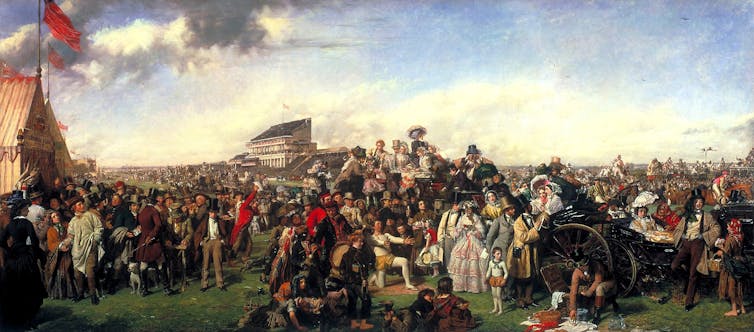
A work of quite stunning obscurity, Giuseppe Gabrielli’s painting The National Gallery 1886, Interior of Room 32 is not currently on display. But it is online and it reveals some important questions about the nature of Nature Gallery itself as it celebrated its 200th year.
We know next to nothing about the artist. We know still less about the people he depicted. That man in the top hat and blue bow tie, the pair of serious women with their lace-trimmed dresses and open guidebook, the young couple and the small family – two elderly parents and a middle-aged daughter – are all anonymous and seem likely to remain unidentified.
This article is part of our series marking 200 years of the National Gallery. These articles use highlights from the gallery’s collection to tell unsung stories of British history.
The status of the painting is as ambiguous as its origins. It is on loan to the National Gallery from the Government Art Collection and, at present, is inaccessible to the public. Like almost 2,000 other pictures in the National Gallery collection, there simply isn’t room for it on the walls, so it is locked away in a vault.
I have chosen to talk about it, however, because its subject is instantly recognisable. This is Room 32 of the National Gallery, which now displays Italian art of the 17th century. The pictures in this scene are also Italian, although they are older – chiefly from the Cinquecento, the age of Leonardo da Vinci, Raphael and Michelangelo.
Using a Victorian catalogue of the gallery, it’s possible to see just how accurately Gabrielli captured his subject. There, by the door, is Saint Roche by Paolo Morando (1518). Just above it to the right is The Virgin and Child with Saint Anneby Gerolamo dai Libri, which was also painted in the 1510s.
These paintings had been hung on the walls in precisely those places when the room opened in 1876. Two years later, the gallery acquired Botticelli’s Adoration of the Kings (circa 1470), and it is the picture that is hanging on the screen to the right.
Every detail – from the chairs, which were acquired in 1856, to the red colouring of the walls, which replaced a more sombre olive green throughout the National Gallery from 1861 – is designed to convince the viewer that they are seeing a wholly accurate portrayal of the place.
In that sense, The National Gallery 1886, Interior of Room 32 is a natural successor to the many minutely observed panoramas of the Victorian period, and especially William Powell Frith’s epic painting, The Derby Day, which proved such a hit when first unveiled in 1858 that barriers had to be put up to protect it from over-excited crowds.

Just like Frith’s more popular painting, though, it is important not to approach Gabrielli’s picture uncritically. We mustn’t be so dazzled by all the detail and the painstaking attempts at accuracy that we forget to ask questions about what we see.
What the painting tells us
Not least, it’s worth pausing to think about who we can see in this image. Smartly – even expensively – attired, these people are far from poor. Top hats and frock coats marked men out as upper class. The lace trimmings on even the most sombre of women’s outfits were similarly intended to communicate a certain status.
It is true to say that, from the first, the National Gallery was intended to be the resort of the respectable. Even those who believed it should be free in order to enable the impoverished to encounter art nonetheless urged that entrance should be restricted to the “decently dressed”.
But Gabrielli’s subjects are not the self-improving artisans that many had hoped would be attracted to the place. The only representatives of the working-class are the uniformed “keepers”, who were employed to prevent the unruly or undesirable from spoiling the rather refined atmosphere.
For the influential Victorian art critic John Ruskin, such class distinctions were inevitable, and even desirable. Called before a parliamentary committee in 1860,he argued that the institution should keep its “precious works of art” separate from any collection intended for the working class.
Yet, of course, even talk of such a distinction suggested that there were limits as to how truly national the National Gallery actually was. Still more troublingly, it might imply that there were limits as to who could be included within the nation itself.
Read more: National Gallery 200: Giovanni Girolamo Savoldo’s Mary Magdalene is a powerful piece of storytelling
Painted as the Third Reform Act was passed, granting votes for the first time to large numbers of working-class men, Gabrielli’s impeccably pukka group dangerously suggested that the newly enfranchised might still be excluded from aspects of national life.
Although little known, The National Gallery 1886, Interior of Room 32 is a helpful reminder that the even the most obscure elements of the collection can be revealing. In this case, it exposes two fundamental questions about the institution itself. First, what makes it national? Second, who or what is the nation? These are questions that have haunted the gallery since its foundation. They remain unanswered to this day.
![]()
William Whyte does not work for, consult, own shares in or receive funding from any company or organisation that would benefit from this article, and has disclosed no relevant affiliations beyond their academic appointment.



